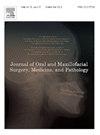Dendritic cells and vascular endothelial growth factor-C in human oral squamous cell carcinoma
IF 0.4
Q4 DENTISTRY, ORAL SURGERY & MEDICINE
Journal of Oral and Maxillofacial Surgery Medicine and Pathology
Pub Date : 2024-09-05
DOI:10.1016/j.ajoms.2024.09.002
引用次数: 0
Abstract
Objective
Dendritic cells (DCs) are antigen-presenting cells that can activate naive T cells and thus play a role in tumor immunity. Vascular endothelial growth factors (VEGFs) produced and secreted by various cancers have been reported to inhibit DC differentiation from progenitor cells. However, the relationship between VEGF-C and DCs in oral squamous cell carcinoma (OSCC) remains unclear.
Methods
Formalin-fixed paraffin-embedded samples of 172 OSCCs were studied. Immunohistological staining was performed to determine the density of S100- and CD1a- positive DCs, D2–40-positive lymphatic vessels, and the grade of VEGF-C expression in OSCCs. OSCC cell lines were cultured and examined for VEGF-C secretion using ELISA.
Results
In comparison to pathological lymph node-negative (PN-) cases, the density of DCs in cancer tissues was significantly lower in PN-positive (PN+) cases, whereas the lymphatic vessel density of cancer tissues was significantly higher in PN+ cases. The density of DCs decreased significantly with increasing VEGF-C expression, indicating a weak inverse relationship. There was a strong positive correlation between VEGF-C expression and lymphatic vessel density. ELISA revealed VEGF-C secretion in various OSCC cell lines, particularly HSC-3, and this increased over time.
Conclusions
These results indicate that VEGF-C expressed by OSCC may increase lymphangiogenesis and create an environment that promotes lymph node metastasis.
求助全文
约1分钟内获得全文
求助全文
来源期刊

Journal of Oral and Maxillofacial Surgery Medicine and Pathology
DENTISTRY, ORAL SURGERY & MEDICINE-
CiteScore
0.80
自引率
0.00%
发文量
129
审稿时长
83 days
 求助内容:
求助内容: 应助结果提醒方式:
应助结果提醒方式:


